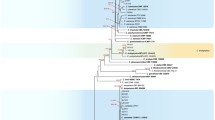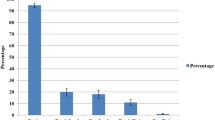Abstract
Anthracnose disease of Proteaceae has in the past chiefly been attributed to infections by C. acutatum, C. boninense and C. gloeosporioides. In the present study, a multi-locus phylogenetic analysis (ACT, CAL, CHS-1, GAPDH, GS, ITS, TUB2) revealed that strains of the C. gloeosporioides complex associated with Proteaceae belong to at least six species. These include C. alienum, C. aotearoa, C. kahawae (subsp. ciggaro), C. siamense, and two new taxa, C. proteae and C. grevilleae. The most economically important pathogen of Proteaceae seems to be C. alienum, and not C. gloeosporioides as previously reported. All taxa associated with Proteaceae are morphologically described on different media in culture, except strains of C. siamense, which proved to be sterile. Furthermore, C. populi is synonymised with C. aenigma.






Similar content being viewed by others
References
Baxter AP, Van der westhuizen GCA, Eicker A (1983) Morphology and taxonomy of South African isolates of Colletotrichum. S Afr J Bot 2:259–289
Bondartseva-Monteverde VN, Guntner LS, Novoselova ED (1936) The parasitic fungi in the greenhouse of the Botanical Institute of the Academy of Science of the USSR. Trudy Botanicheskogo Instituta Akademii Nauk SSSR II 3:715–801
Cai L, Hyde KD, Taylor PWJ, Weir BS, Waller J, Abang MM, Zhang JZ, Yang YL, Phoulivong S, Liu ZY, Prihastuti H, Shivas RG, McKenzie EHC, Johnston PR (2009) A polyphasic approach for studying Colletotrichum. Fungal Divers 39:183–204
Cannon PF, Buddie AG, Bridge PD (2008) The typification of Colletotrichum gloeosporioides. Mycotaxon 104:189–204
Carbone I, Kohn LM (1999) A method for designing primer sets for speciation studies in filamentous ascomycetes. Mycologia 91:553–556
Crous PW, Groenewald JZ (2005) Hosts, species and genotypes: opinions versus data. Australas Plant Path 34:463–470
Crous PW, Palm ME (1999) Systematics of selected foliicolous fungi associated with leaf spots of Proteaceae. Mycol Res 103:1299–1304
Crous PW, Summerell BA, Taylor JE, Bullock S (2000) Fungi occurring on Proteaceae in Australia: selected foliicolous species. Australas Plant Path 29:267–278
Crous PW, Denman S, Taylor JE, Swart L, Palm ME (2004a) Cultivation and diseases of Proteaceae: Leucadendron, Leucospermum and Protea. Centraalbureau voor Schimmelcultures (CBS), Utrecht
Crous PW, Gams W, Stalpers JA, Robert V, Stegehuis G (2004b) MycoBank: an online initiative to launch mycology into the 21st century. Stud Mycol 50:19–22
Crous PW, Groenewald JZ, Risède JM, Simoneau P, Hywel-Jones NL (2004c) Calonectria species and their Cylindrocladium anamorphs: species with sphaeropedunculate vesicles. Stud Mycol 50:415–430
Crous PW, Summerell BA, Swart L, Denman S, Taylor JE, Bezuidenhout CM, Palm ME, Marincowitz S, Groenewald JZ (2011) Fungal pathogens of Proteaceae. Persoonia 27:20–45
Damm U, Mostert L, Crous PW, Fourie PH (2008) Novel Phaeoacremonium species associated with necrotic wood of Prunus trees. Persoonia 20:87–102
Damm U, Woudenberg JHC, Cannon PF, Crous PW (2009) Colletotrichum species with curved conidia from herbaceous hosts. Fungal Divers 39:45–87
Damm U, Cannon PF, Woudenberg JHC, Crous PW (2012a) The Colletotrichum acutatum species complex. Stud Mycol 73:37–113
Damm U, Cannon PF, Woudenberg JHC, Johnston PR, Weir BS, Tan YP, Shivas RG, Crous PW (2012b) The Colletotrichum boninense species complex. Stud Mycol 73:1–36
Doyle VP, Oudemans PV, Rehner SA, Litt A (2013) Habitat and host indicate lineage identity in Colletotrichum gloeosporioides s. l. from wild and agricultural landscapes in North America. PLoS One 8:e62394
Gardes M, Bruns TD (1993) ITS primers with enhanced specificity for basidiomycetes - application to the identification of mycorrhizae and rusts. Mol Ecol 2:113–118
Glass NL, Donaldson GC (1995) Development of primer sets designed for use with the PCR to amplify conserved genes from filamentous ascomycetes. Appl Environ Microb 61:1323–1330
González Fragoso R (1923, publ. 1924) Contribución a la flora micológica Lusitánica. Boletim da Sociedade Broteriana Ser. II, 2:3–83
Guerber JC, Liu B, Correll JC, Johnston PR (2003) Characterization of diversity in Colletotrichum acutatum sensu lato by sequence analysis of two gene introns, mtDNA and intron RFLPs, and mating compatibility. Mycologia 95:872–895
Hyde KD, Cai L, McKenzie EHC, Yang YL, Zhang JZ, Prihastuti H (2009) Colletotrichum: a catalogue of confusion. Fungal Divers 39:1–17
Katoh K, Toh H (2010) Parallelization of the MAFFT multiple sequence alignment program. Bioinformatics 26:1899–1900
Knox-Davies PS (1981) Comments on fungus diseases of plants indigenous to the South-Western Cape. Veld and Flora 67:88–91
Knox-Davies PS, Van Wyk PS, Marasas WFO (1986) Diseases of proteas and their control in the South-Western Cape. Acta Hortic 185:189–200
Li Z, Liang YM, Tian CM (2012) Characterization of the causal agent of poplar anthracnose occurring in the Beijing region. Mycotaxon 120:277–286
Liu F, Hyde KD, Cai L (2011) Neotypification of Colletotrichum coccodes, the causal agent of potato black dot disease and tomato anthracnose. Mycology 2:248–254
Liu F, Hu DM, Cai L (2012) Conlarium duplumascospora gen. et. sp. nov. and Jobellisia guangdongensis sp. nov. from freshwater habitats in China. Mycologia 104:1178–1186
Lubbe CM, Denman S, Cannon PF, Groenewald JZE, Lamprecht SC, Crous PW (2004) Characterization of Colletotrichum species associated with diseases of Proteaceae. Mycologia 96:1268–1279
Lubbe CM, Denman S, Lamprecht SC, Crous PW (2006) Pathogenicity of Colletotrichum species to Protea cultivars. Australas Plant Path 35:37–41
Marincowitz S, Crous PW, Groenewald JZ, Wingfield MJ (2008a) Microfungi occurring on Proteaceae in the fynbos. CBS Biodiversity Series 7. Centraalbureau voor Schimmelcultures, Utrecht
Marincowitz S, Groenewald JZ, Wingfield MJ, Crous PW (2008b) Species of Botryosphaeriaceae occurring on Proteaceae. Persoonia 21:111–118
Nirenberg HI (1976) Untersuchungen über die morphologische und biologische Differenzierung in der Fusarium-Sektion Liseola. Mitteilungen aus der Biologischen Bundesanstalt für Land- und Forstwirtschaft Berlin-Dahlem 169:1–117
Nylander JAA (2004) MrModeltest v2. Program distributed by the author. Evolutionary Biology Centre, Uppsala University 2
O’Donnell K, Cigelnik E (1997) Two divergent intragenomic rDNA ITS2 types within a monophyletic lineage of the fungus Fusarium are nonorthologous. Mol Phylogenet Evol 7:103–116
O’Donnell K, Nirenberg HI, Aoki T, Cigelnik E (2000) A multigene phylogeny of the Gibberella fujikuroi species complex: Detection of additional phylogenetically distinct species. Mycoscience 41:61–78
Pavgi MS, Singh UP (1964) Parasitic fungi from north India. Mycopathologia 23:188–196
Peng LJ, Yang YL, Hyde KD, Bahkali AH, Liu ZY (2012) Colletotrichum species on Citrus leaves in Guizhou and Yunnan provinces, China. Cryptogamie Mycol 33:267–283
Peng LJ, Sun T, Yang YL, Cai L, Hyde KD, Bahkali AH, Liu ZY (2013) Colletotrichum species on grape in Guizhou and Yunnan provinces, China. Mycoscience 54:29–41
Penzig AGO (1882) Funghi agrumicoli. Contribuzione allo studio dei funghi parassiti degli agrumi. Michelia 2:385–508
Phoulivong S, Cai L, Parinn N, Chen H, Abd-Elsalam KA, Chukeatirote E, Hyde KD (2010) A new species of Colletotrichum from Cordyline fruticosa and Eugenia javanica causing anthracnose disease. Mycotaxon 114:247–257
Prihastuti H, Cai L, Chen H, McKenzie EHC, Hyde KD (2009) Characterization of Colletotrichum species associated with coffee berries in northern Thailand. Fungal Divers 39:89–109
Rayner RW (1970) A mycological colour chart. Commonwealth Mycological Institute, Kew, UK
Rojas EI, Rehner SA, Samuels GJ, Van Bael SA, Herre EA, Cannon P, Chen R, Pang J, Wang R, Zhang Y (2010) Colletotrichum gloeosporioides s.l. associated with Theobroma cacao and other plants in Panamá: multilocus phylogenies distinguish host-associated pathogens from asymptomatic endophytes. Mycologia 102:1318–1338
Ronquist F, Huelsenbeck JP (2003) MrBayes 3: Bayesian phylogenetic inference under mixed models. Bioinformatics 19:1572–1574
Sharma G, Kumar N, Weir BS, Hyde KD, Shenoy BD (2013) The ApMat marker can resolve Colletotrichum species: a case study with Mangifera indica. Fungal Divers. doi:10.1007/s13225-013-0247-4
Spegazzini CL (1878) Ampelomiceti Italici, ossia enumerazione, diagnosi e storia dei principali parassiti della vite. Rivista Viticolt. Enologia 2:405–411 [nos 7–9]
Stephenson SA, Green JR, Manners JM, Maclean DJ (1997) Cloning and characterisation of glutamine synthetase from Colletotrichum gloeosporioides and demonstration of elevated expression during pathogenesis on Stylosanthes guianensis. Curr Genet 31:447–454
Swofford DL (2002) PAUP 4.0 b10: Phylogenetic analysis using parsimony (* and other methods), v. 4.0b10. Computer programme. Sinauer Associates, Sunderland
Tamura K, Peterson D, Peterson N, Stecher G, Nei M, Kumar S (2011) MEGA5: molecular evolutionary genetics analysis using maximum likelihood, evolutionary distance, and maximum parsimony methods. Mol Biol Evol 28:2731–2739
Taylor JE, Crous PW, Palm ME (2001a) Foliar and stem fungal pathogens of Proteaceae in Hawaii. Mycotaxon 78:449–490
Taylor JE, Crous PW, Swart L (2001b) Foliicolous and caulicolous fungi associated with Proteaceae cultivated in California. Mycotaxon 78:75–103
Taylor JE, Lee S, Crous PW (2001c) Biodiversity in the Cape Floral Kingdom: fungi occurring on Proteaceae. Mycol Res 105:1480–1484
Von Arx JA (1957) Die Arten der Gattung Colletotrichum Cda. Phytopathol Z 29:413–468
Von Broembsen SL (1989) Colletotrichum die-back. In: Handbook of diseases of cut-flower Proteas. Victoria, Australia: International Protea Association, pp 16–19
Waller JM, Bridge PD, Black R, Hakiza G (1993) Characterization of the coffee berry disease pathogen, Colletotrichum kahawae sp. nov. Mycol Res 97:989–994
Wang XX, Wang B, Liu JL, Chen J, Cui XP, Jiang H, Peng XD (2010) First reports of anthracnose caused by Colletotrichum gloesporioides on ramie in China. Plant Dis 94:1508
Weir BS, Johnston PR (2010) Characterisation and neotypification of Gloeosporium kari Hori as Colletotrichum horii nom. nov. Mycotaxon 111:209–219
Weir BS, Johnston PR, Damm U (2012) The Colletotrichum gloeosporioides species complex. Stud Mycol 73:115–180
White TJ, Bruns TD, Lee S, Taylor J (1990) Amplification and direct sequencing of fungal ribosomal RNA genes for phylogenetics. In: White TJ, Sninsky JJ, Gelfand DH, Innin MA (eds) PCR protocols: a guide to methods and applications. Academic, San Diego, pp 315–322
Wikee S, Cai L, Pairin N, McKenzie EHC, Su YY, Chukeatirote E, Thi HN, Bahkali AH, Moslem MA, Abdelsalam K, Hyde KD (2011) Colletotrichum species from Jasmine (Jasminum sambac). Fungal Divers 46:171–182
World Trade Organisation (1994) Agreement on the application of sanitary and phytosanitary measures. World Trade Organisation, Geneva
Wright MG, Saunderson MD (1995) Protea plant protection: from the African context to the international arena. Acta Hortic 387:129–139
Yang YL, Liu ZY, Cai L, Hyde KD, Yu ZN, Mckenzie EHC (2009) Colletotrichum anthracnose of Amaryllidaceae. Fungal Divers 39:123–146
Yang YL, Cai L, Yu ZN, Liu ZY, Hyde KD (2011) Colletotrichum species on Orchidaceae in southwest China. Cryptogamie Mycol 32:229–253
Zhou H, Brockington M, Jungbluth H, Monk D, Stanier P, Sewry CA, Moore GE, Muntoni F (2006) Epigenetic allele silencing unveils recessive RYR1 mutations in core myopathies. Am J Hum Genet 79:859–868
Acknowledgments
We thank the curators of the CBS culture collection for kindly supplying isolates for this study. We are also very grateful to Dr. Roger G. Shivas who gave valuable suggestions to our work on Colletotrichum taxonomy, during his academic visit to China (funded by NSFC 31110103906). This study was financially supported by the National Natural Science Foundation of China (NSFC 31070020) and the External Cooperation Program of the Chinese Academy of Sciences (GJHZ1310). This research was also supported by the Dutch Ministry of Agriculture, Nature and Food Quality through an endowment of the FES programme “Versterking infrastructuur Plantgezondheid”.
Author information
Authors and Affiliations
Corresponding author
Rights and permissions
About this article
Cite this article
Liu, F., Damm, U., Cai, L. et al. Species of the Colletotrichum gloeosporioides complex associated with anthracnose diseases of Proteaceae . Fungal Diversity 61, 89–105 (2013). https://doi.org/10.1007/s13225-013-0249-2
Received:
Accepted:
Published:
Issue Date:
DOI: https://doi.org/10.1007/s13225-013-0249-2




